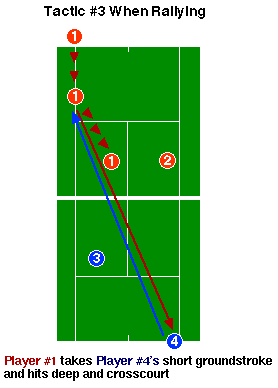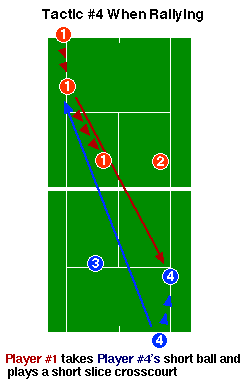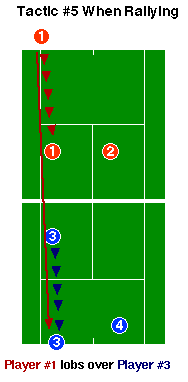|
TennisOne Lessons

Strategy Lesson
of the Week
Doubles: How to Play Against a One Up/One Back Team
Strategy Question of the Week
How do we play against a team that plays one up (at the net) and one back
(at the baseline)?
Answer
(Note: This is a basic doubles lesson aimed at beginning and intermediate
club doubles players. For the sake of readability, it is assumed that these
are two female doubles teams).
First and foremost, your team needs to determine your own style of play
before you look over the net and decide how to play your opponents. Are
you a team that plays one up and one back like your opponents or are you
a team that tries to come in every chance you get? Once you have determined
your own style of play then and only then are you ready to know how to face
the opposition.
In Part 2 of this answer, we'll look at the strategy if you and your
partner like to come to the net. Part 2a focuses on tactics to use when
your team is serving, and part 2b focuses on tactics for the receiving doubles
team.
How to Play Against a One Up/One Back Team--
When Your Team Likes To Come to the Net
(Tactics for Rallying)
By Monty Basynat, TennisONE Editor
If your doubles team likes to seize control of the match by coming into
the net, you have definite advantages over teams that play one up, one back.
In general, you are in a much better position to volley all balls hit at
you, which gives your team many more opportunities for a variety of forcing
and winning shots. Your opponents' one up/one back positioning, on
the other hand, will make them hit more defensive groundstrokes
and lobs as well as create spacing problems which you and your partner can
exploit with your superior positioning closer to the net.
So the answer to the question in the title is to be found in all the smart
ways to come to the net. I've broken these down into five tactics for coming
to the net.
One cautionary note: All the positioning of the players in the doubles lessons
shown here will change depending on a variety of factors, including your
shot velocity and placement, your opponents' positioning, as well as your
opponents' strengths and weaknesses. In other words, there is no one correct
position during the dynamic movement and positioning required in doubles.
In particular, how close your team closes to the net and how tightly
you guard your alleys depends on a variety of factors you must assess and
respond to instantly.
 If both teams are in a one up/one
back position, and the baseline players are exchanging crosscourt groundstrokes,
how does your team get to the net? Tactic #3 is very basic: wait until your
opponent (Player #4 in this case) hits a short ball. You, as Player #1,
have been patient, waiting for this short ball. When it comes, drive your
ball deep and crosscourt. Because you're now closer to the net, you have
time to move into proper net position. Now both you and your partner are
at the net, and Player #4 must try to pass or lob you, both defensive percentage
plays (and certainly lower percentage options than your team holds). If both teams are in a one up/one
back position, and the baseline players are exchanging crosscourt groundstrokes,
how does your team get to the net? Tactic #3 is very basic: wait until your
opponent (Player #4 in this case) hits a short ball. You, as Player #1,
have been patient, waiting for this short ball. When it comes, drive your
ball deep and crosscourt. Because you're now closer to the net, you have
time to move into proper net position. Now both you and your partner are
at the net, and Player #4 must try to pass or lob you, both defensive percentage
plays (and certainly lower percentage options than your team holds).

Tactic #4 is very similar to the last one, only this time you (as Player
#1) will play a slice (underspin) angled shot. Just like your earlier tactic
of playing the short, angled volley, this forces Player #4 to scurry
several steps into the court and try to hit a low, skidding
ball past you and your partner set up at the net. The odds are very
much in your team's favor. Again, your partner, Player #2 must adjust how
closely she covers her alley depending on how low and damaging your slice
shot has been.

Tactic #5 can be used any time the opposing team's net player (Player #3
here) has moved too close to the net. Basically, the lob over the
opposing team's net player enables your baseline player (Player
#1) to switch positions with the opposing team's net player (Player
#3). Once again your team is up at the net, in an advantageous position,
and once again, your opponents are playing from the baseline. Too bad for
them.
Send in Your Strategy Questions to TennisONE
If you think you have a good TennisONE Strategy Question, please send an
email to: question@tennisone.com.
|
|
|